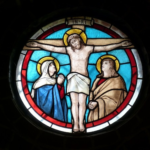We run our website the way we wished the whole internet worked: we provide high quality original content with no ads. We are funded solely by your direct support. Please consider supporting this project.

Cruciform Theology in Four Steps
The culmination of the biblical narrative of the cross reframes everything about who God is, what it means to have faith in God, and how we read the Bible! The entire Old Testament leading up to the crucified Christ must be interpreted with a view toward discerning how it anticipates and points toward this definitive revelation. This brings us to the all-important question: How does the crucified Christ reframe the Old Testament’s disturbing portraits of God such that they bear witness to the non-violent, self-sacrificial, enemy-embracing God revealed on the cross? Let’s answer this in four steps.
Step 1: How The Cross Reveals God
The first step involves asking: How does the crucified Christ become the supreme revelation of God for us?
“The message of the cross” tells us is that in Christ, God was bearing the sin of the world to reconcile the world to himself. Thus, the cross is simultaneously supremely ugly and supremely beautiful to those who believe. The surface of this event is revoltingly ugly, for it reflects the ugly sin that Jesus bore. But to those who by faith see beyond this surface appearance, the cross also reveals the supreme beauty of a God who, out of love, was willing to bear our sin, suffer our curse, and to thereby take on this revoltingly ugly, sin-mirroring, surface appearance.
Step 2: Reading Scripture with a Cross-Informed Faith
In this step, we ask Where else might we need faith? If the cross reveals what God is truly like, it reveals what God has always been like. In this light, we should read Scripture wondering where else God might have revealed himself the way he did on the cross? Where else might we find God revealing himself by stooping to bear the sin of his people, thereby taking on an appearance that reflects the ugliness of this sin?
This is precisely how we should understand all depictions of God commanding and engaging in violence. For example, when Yahweh is depicted as vowing to not let mercy or compassion stop him from smashing families together (Jer 13:14), I submit that we are seeing a reflection of the ugly, fallen, and culturally-conditioned way Jeremiah and other ancient Israelites viewed God.
In other words, Jeremiah’s horrific depiction of God demonstrates that God’s people at this time clearly believed Yahweh was capable of smashing families together, just as the surrounding other groups of the time believed about their deities. Yet, the very fact that God allowed fallen depictions like this to be incorporated into his “God-breathed” word reveals that the humble, self-sacrificial, sin-bearing God who is fully revealed on the cross was not above stooping to meet his people where they were by bearing their sin.
Step 3: A Cross-Centered Conception of God’s “Breathing”
With this step, we ask: What does it mean for the Scriptures to be “God-breathed.” Insofar as the cross is beautiful, it reflects God acting toward us. Insofar as the cross is ugly, however, it reflects God humbly allowing other agents to act upon him. In this light, I submit that we should read our “God-breathed” Scripture with the awareness that it was “breathed” in a relational, rather than a unilateral, manner. It not only reflects God acting toward his people; it also reflects God humbly allowing the foolishness and weakness of his fallen and culturally-conditioned people to act upon him, thereby conditioning the way he appears in his written revelation.
Therefore, the degree that any portrait of God reflects the non-violent, self-sacrificial, enemy-embracing character of God that was most fully revealed on Calvary, we should conclude that it reflects God acting toward his people. But to the degree that any portrait depicts God’s character in ways that are inconsistent with the character he revealed on Calvary, we must conclude that it reflects God humbly stooping to allow his fallen people to act on him, thereby conditioning how he appears within the written revelation that he “breathed.”
Step 4: The Relational, Non-Coercive God
This final step asks: Why is God Willing To Stoop? God’s goal is to have a people who participate in and mirror his triune love in their relationship with him, with each other, and with the rest of creation. Because God sovereignly chose to create a world in which true freedom exists, he cannot override the personhood of people by controlling them. He must work with them, and through them, by means of a loving influence. This is what we should expect, given that we know that the kind of power God relies on is revealed on the cross (I Cor 1:18). Since God does not lobotomize people to get them where he wishes they were, he must be willing to humbly stoop to relate to them as they are. Which, in turn, means that God must patiently bear people’s sin as he continues to influence them in the direction he wants for them.
This is why God has always been willing stoop to allow the sin of his people—including their sinful conceptions of him—to condition how he appears whenever he “breathes” revelations of himself. His “breathing” reflects the reciprocal give-and-take of a non-coercive relationship because God is an inherently relational God and because he made us as decision-making persons who are capable of authentic relationships.
Photo credit: Endre Majoros via Visualhunt / CC BY
Category: General
Tags: Cross, Cruciform Theology, God's Love
Topics: Interpreting Violent Pictures and Troubling Behaviors
Related Reading

God’s Love is Cruciform
Paul instructs us in what it means to follow Jesus, when he stated, “Follow God’s example, therefore, as dearly loved children and walk in the way of love, just as Christ loved us and gave himself up for us as a fragrant offering and sacrifice to God (Eph 5:1-2). Here Paul defines what it means to…

Podcast: Why Did Jesus Say He Came to Bring a Sword?
Greg considers what Jesus meant when he said he had come to bring a sword. http://traffic.libsyn.com/askgregboyd/Episode_0312.mp3

Who Rules Governments? God or Satan? Part 2
In the previous post, I raised the question of how we reconcile the fact that the Bible depicts both God and Satan as the ruler of nations, and I discussed some classical ways this has been understood. In this post I want to offer a cross-centered approach to this classical conundrum that provides us with…

How NOT to be Christ-Centered: A Review of God With Us – Part II
In Part I of my review of Scott Oliphint’s God With Us we saw that Oliphint is attempting to reframe divine accommodation in a Christ-centerd way. Yet, while he affirms that “Christ is the quintessential revelation of God,” he went on to espouse a classical view of God that was anchored in God’s “aseity,” not…

Cruciform Aikido Pt 1: Jesus and the Violent God
Note: Today, we are beginning a 4-part series on the subject of divine judgement called “Cruciform Aikido.” We will be publishing this once a week alongside Greg’s introduction to ReKnew series. When most people think of God judging sinners, they imagine an angry God who acts violently as he vents his wrath and brings vengeance on people.…

Revolting Beauty
In this sermon clip, Greg shares the story of how foster parents entered into the pain of a severely abused child and demonstrated compassion rather than judgment when she displayed puzzling and revolting behaviors. This moving story illustrates the way that God enters into our sin and our curse on the cross, and gives us…
